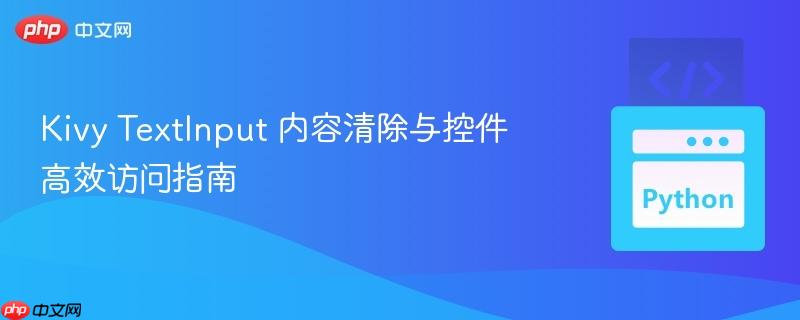
本教程详细讲解了在 kivy 应用中正确清除 textinput 控件内容的两种方法。首先,纠正了常见的属性拼写错误(`.txt`应为`.text`)。其次,推荐使用 kivy 提供的 `self.ids` 机制,通过控件的 id 直接访问和操作 kv 文件中定义的组件,从而简化 python 代码,提高可读性和维护性,避免不必要的 `objectproperty` 定义。
在 Kivy 应用程序开发中,尤其是在构建用户界面时,经常需要处理用户输入。例如,在用户完成注册或登录操作后,清空 TextInput 控件中的内容是一个常见的需求,以提供清晰的用户体验。然而,开发者有时会遇到清除文本无效的问题,这通常源于对 Kivy 控件属性的不熟悉或使用方式不当。本教程将深入探讨如何正确地清除 TextInput 内容,并介绍一种更优雅、高效的 Kivy 控件访问方式。
许多开发者在尝试清除 TextInput 控件的文本时,可能会错误地使用 .txt 属性。Kivy 的 TextInput 控件存储其当前文本内容的属性是 text,而不是 txt。因此,尝试将 self.createusername.txt = "" 或 self.createpassword.txt = "" 设置为空字符串是无效的,因为它指向了一个不存在的属性,自然无法改变控件的显示内容。
正确的做法是使用 .text 属性来获取或设置 TextInput 的文本内容。
例如,以下是修正后的 resetType 函数:
class CreateWindow(Screen):
# ... 其他代码 ...
def resetType(self):
# 正确地清除 TextInput 内容,使用 .text 属性
self.createusername.text = ""
self.createpassword.text = ""
print("TextInput 内容已清除")通过将 txt 更正为 text,TextInput 控件的显示内容就能被成功清空。
除了修正属性名称外,Kivy 还提供了一种更推荐、更简洁的方式来访问在 KV 语言文件中通过 id 定义的控件,即使用 self.ids 字典。
在 Kivy 中,当你在 KV 文件中为某个控件指定 id 时,Kivy 会自动将该控件的引用存储在其父级 Screen 或 Widget 实例的 ids 字典中。这意味着你无需在 Python 类中显式地定义 ObjectProperty 来链接 KV 文件中的控件,可以直接通过 self.ids.
修改前的 Python 代码(使用 ObjectProperty):
class CreateWindow(Screen):
createusername = ObjectProperty(None)
createpassword = ObjectProperty(None)
def createAccountButton(self):
createdusername = str(self.createusername.text)
createdpassword = str(self.createpassword.text)
# ... 文件写入逻辑 ...
self.resetType()
def resetType(self):
self.createusername.txt = "" # 错误示例
self.createpassword.txt = "" # 错误示例
print("Working")修改前的 KV 代码(与 ObjectProperty 绑定):
<CreateWindow>:
name: "Create"
createusername: createusername # 绑定到 ObjectProperty
createpassword: createpassword # 绑定到 ObjectProperty
FloatLayout:
# ... 其他控件 ...
TextInput:
id: createpassword
# ...
TextInput:
id: createusername
# ...使用 self.ids 后的 Python 代码:
class CreateWindow(Screen):
# 不再需要定义 ObjectProperty
# createusername = ObjectProperty(None)
# createpassword = ObjectProperty(None)
def createAccountButton(self):
# 直接通过 self.ids 访问控件的 text 属性
createdusername = str(self.ids.createusername.text)
createdpassword = str(self.ids.createpassword.text)
# 确保文件操作的健壮性,使用 with 语句
with open("database.txt", "a") as database:
database.write(f"{createdusername},{createdpassword}\n") # 使用 f-string 更清晰
print("数据已写入文件")
self.resetType()
def resetType(self):
# 通过 self.ids 访问并清除 TextInput 内容
self.ids.createusername.text = ""
self.ids.createpassword.text = ""
print("TextInput 内容已清除")使用 self.ids 后的 KV 代码:
<CreateWindow>:
name: "Create"
# 不再需要将 id 绑定到 ObjectProperty
# createusername: createusername
# createpassword: createpassword
FloatLayout:
Button:
text:"Login"
size_hint: 0.5, 0.1
pos_hint: {"x":0.25, "y":0.3}
on_press: root.createAccountButton() # 调用方法
on_release: app.root.current = "login"
# 注意:如果 resetType 也要在按钮点击时调用,需要显式调用
# on_press: root.createAccountButton(); root.resetType()
# 或者在 createAccountButton 内部调用 resetType
TextInput:
id: createpassword # 保持 id 定义
size_hint: 0.25, 0.1
pos_hint: {"x":0.5, "y":0.5}
TextInput:
id: createusername # 保持 id 定义
size_hint: 0.25, 0.1
pos_hint: {"x":0.5, "y":0.6}
Label:
font_size: '40'
text:"Create Account"
size_hint: 0.5, 0.5
pos_hint: {"x":0.25, "y":0.6}
Label:
font_size: '25'
text:"Username:"
size_hint: 0.5, 0.1
pos_hint:{"x":0.1,"y":0.6}
Label:
font_size: '25'
text:"Password:"
size_hint: 0.5, 0.1
pos_hint:{"x":0.1,"y":0.5}完整示例代码(main.py 和 login.kv):
main.py
import kivy
from kivy.app import App
from kivy.uix.widget import Widget
from kivy.uix.floatlayout import FloatLayout
from kivy.properties import ObjectProperty
from kivy.uix.screenmanager import ScreenManager, Screen
from kivy.lang import Builder
class LoginWindow(Screen):
# 示例中未修改,但同样可以通过 self.ids 优化
username = ObjectProperty(None)
password = ObjectProperty(None)
def btn(self):
print(self.username.text, self.password.text)
class CreateWindow(Screen):
# 不再需要 ObjectProperty,直接通过 self.ids 访问
# createusername = ObjectProperty(None)
# createpassword = ObjectProperty(None)
def createAccountButton(self):
# 通过 self.ids 访问 TextInput 的 text 属性
createdusername = str(self.ids.createusername.text)
createdpassword = str(self.ids.createpassword.text)
# 使用 with 语句确保文件正确关闭
with open("database.txt", "a") as database:
database.write(f"{createdusername},{createdpassword}\n")
print("数据已写入文件")
self.resetType() # 在创建账户后清除输入
def resetType(self):
# 正确地清除 TextInput 内容,通过 self.ids 访问
self.ids.createusername.text = ""
self.ids.createpassword.text = ""
print("TextInput 内容已清除")
class RealWindow(Screen):
pass
class WindowManager(ScreenManager):
pass
# 加载 KV 文件
kv = Builder.load_file("login.kv")
class TestApp(App):
def build(self):
return kv
if __name__ == "__main__":
TestApp().run()login.kv
WindowManager:
#: import NoTransition kivy.uix.screenmanager.NoTransition
transition: NoTransition()
LoginWindow:
CreateWindow:
RealWindow:
<LoginWindow>:
name: "login"
username: username # 仍然使用 ObjectProperty 绑定,可按需优化
password: password # 仍然使用 ObjectProperty 绑定,可按需优化
FloatLayout:
Button:
text:"Log In"
size_hint: 0.5, 0.1
pos_hint: {"x":0.25, "y":0.3}
on_press: root.btn()
Button:
text:"Create Account"
size_hint: 0.3, 0.05
pos_hint: {"x":0.36, "y":0.20}
on_release:
app.root.current = "Create"
TextInput:
id: password
size_hint: 0.25, 0.1
pos_hint: {"x":0.5, "y":0.5}
TextInput:
id:username
size_hint: 0.25, 0.1
pos_hint: {"x":0.5, "y":0.6}
Label:
font_size: '40'
text:"Log In"
size_hint: 0.5, 0.5
pos_hint: {"x":0.25, "y":0.6}
Label:
font_size: '25'
text:"Username:"
size_hint: 0.5, 0.1
pos_hint:{"x":0.1,"y":0.6}
Label:
font_size: '25'
text:"Password:"
size_hint: 0.5, 0.1
pos_hint:{"x":0.1,"y":0.5}
<CreateWindow>:
name: "Create"
# 移除 ObjectProperty 绑定
# createusername: createusername
# createpassword: createpassword
FloatLayout:
Button:
text:"Login"
size_hint: 0.5, 0.1
pos_hint: {"x":0.25, "y":0.3}
on_press: root.createAccountButton() # 调用创建账户方法
on_release: app.root.current = "login" # 切换回登录界面
TextInput:
id: createpassword # 保持 id
size_hint: 0.25, 0.1
pos_hint: {"x":0.5, "y":0.5}
TextInput:
id: createusername # 保持 id
size_hint: 0.25, 0.1
pos_hint: {"x":0.5, "y":0.6}
Label:
font_size: '40'
text:"Create Account"
size_hint: 0.5, 0.5
pos_hint: {"x":0.25, "y":0.6}
Label:
font_size: '25'
text:"Username:"
size_hint: 0.5, 0.1
pos_hint:{"x":0.1,"y":0.6}
Label:
font_size: '25'
text:"Password:"
size_hint: 0.5, 0.1
pos_hint:{"x":0.1,"y":0.5}
<RealWindow>:
name: "Real"通过遵循这些最佳实践,您将能够更有效地在 Kivy 应用程序中管理 TextInput 控件的内容,并编写出更清晰、更专业的 Kivy 代码。
以上就是Kivy TextInput 内容清除与控件高效访问指南的详细内容,更多请关注php中文网其它相关文章!

每个人都需要一台速度更快、更稳定的 PC。随着时间的推移,垃圾文件、旧注册表数据和不必要的后台进程会占用资源并降低性能。幸运的是,许多工具可以让 Windows 保持平稳运行。

Copyright 2014-2025 https://www.php.cn/ All Rights Reserved | php.cn | 湘ICP备2023035733号